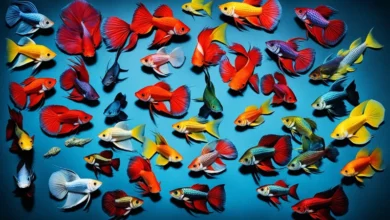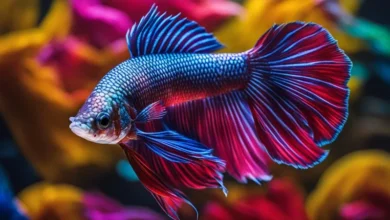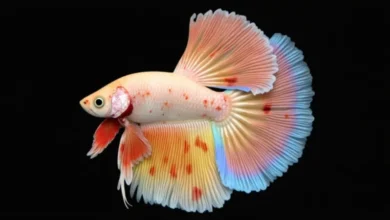
Ever thought about making a colorful Betta fish that shines in any tank? Learning how to breed multicolor betta fish is both fun and eye-opening. It shows you the amazing mix of genes that nature uses to create stunning fish.
Entering the world of multicolor betta breeding means diving into the dance of genes. It’s about understanding how colors like bright reds or complex marbles come to be. With the right knowledge, you can turn your breeding into a success. You’ll see a wide range of beautiful Betta fish born from these fascinating genetic tricks.
Imagine figuring out the mysteries behind colors like advanced reds, Dalmatian markings, and unique marble patterns. This knowledge is key for anyone starting this exciting hobby. Whether it’s shiny metallics or hidden non-red colors, you’ll learn a lot and have a great time doing it.
Ready to make your fish tank dreams come true with colorful Betta fish? This guide will give you all the info you need to start breeding. It’s designed to be easy and fun for all fish lovers, no matter your experience level.
Introduction to Multicolor Betta Fish
Multicolor betta fish are loved for their bright colors and unique patterns. They are a stunning sight in any fish tank. The different shades on these fish make them truly eye-catching.
What is a Multicolor Betta?
A multicolor betta shows off many shades in one fish. This makes them different from bettas which are just one color. In breeding, these fish have a mix of colors because of unique genes. This creates a beautiful variety in their appearance.
Popular Color Varieties
There are many beautiful colors that bettas come in. Some favorite colors include:
- Cherry Red: A bright red is often seen in multicolor bettas.
- Extended Red: A deeper red that spreads over their body and fins.
- Non-Red Varieties: These include shades like yellow, orange, and green. They make multicolor bettas even more colorful.
Breeders work hard to create these colors. They aim to please both new fish lovers and experts with their vibrant fish.
Understanding Color Genetics
The amazing colors of betta fish are tied to their genes. Color genetics mix main and layer colors to create stunning finishes. Breeders use this to get the colors they want. They study this to make sure their bettas are beautiful.
Bettas can have over 700 babies in one batch. This shows the huge mix of colorful babies possible. To keep colors bright, breeders suggest big tanks and special food from the start.
Essential Equipment for Multicolor Betta Fish Breeding
Setting up a good betta breeding environment is key. It ensures the fish reproduce well and stay healthy. This guide covers how to set up a breeding tank, what supplies you need, and how to keep the water just right for breeding.
Breeding Tank Setup
To breed bettas well, you need the right tank setup. A 10-gallon tank for the breeding pair is a good start. After the eggs hatch, move the fry to a 10-gallon tank. For older fry, use tanks that are 30 gallons or more.
Keep the water between 80°F to 85°F with a 25-watt heater. This mimics their natural tropical environment and helps them breed. Use plants like Amazon Sword and Java Fern to give fish places to hide and oxygen.
Required Accessories
Several supplies are needed for a successful breeding environment:
- Sponge Filters: They provide gentle water filtration without hurting fry.
- Indian Almond Leaves: They fight bacteria and encourage breeding.
- Microworm Culture Setup: It’s needed to feed the fry, made from oatmeal and yeast.
- Breeding Net: It keeps the female betta safe and lets you watch her with the male.
- Containers and Jars: You need at least 20 quart-sized containers to keep male fry alone.
- Medication for Ick and Velvet: This is vital to keep developing fry healthy.
- Snails: They help keep the tank clean by eating waste.
Optimal Water Conditions
Good water is crucial for breeding bettas. The pH should be between 6.5 and 7.5. Change 20-25% of the water each week to keep ammonia and nitrate low.
Using Indian Almond Leaves in the water can help. It makes the water more like the bettas’ natural home. A steady water temperature of 80°F to 85°F is best for breeding.

Following these steps for your breeding tank, accessories, and water conditions leads to a rewarding experience. With preparation and care, breeding multicolor bettas is fulfilling.
Selecting and Conditioning Your Betta Pair
Choosing the right betta breeding pair is key to success. Look at their activity level and make sure they’re healthy. Also, check their colors, fin shapes, and sizes. Such traits can help you pick a strong and healthy pair.
After picking your pair, get them ready for breeding. The conditioning period lasts 10 days. Feed them high-quality foods, like bloodworms, and protein-rich fish foods. Spend 5-10 minutes a day on their conditioning.
Creating the right breeding environment is crucial. Fill the tank with water 6 inches deep and keep it at 80 degrees Fahrenheit (26.7 degrees Celsius). A sponge filter, air pump, airline tubing, and regulator are needed for water quality. Use an airflow of 1-3 bubbles per second for the best breeding space.
For aggressive pairs, use a 10-gallon tank. Start the micro worm culture on the first day of conditioning. A well-prepared tank and healthy, well-fed fish can bring forth new life successfully.
Stages of Multicolor Betta Fish Breeding
Breeding multicolor Betta fish goes through many stages. You need to carefully prepare and pay attention to each step. From the tank setup to making sure the baby fish (fry) survive, each phase is crucial in the Betta fish breeding journey.

Pre-Breeding Preparations
To begin, prepare a 10-gallon breeding tank. Keep the water at 80 degrees Fahrenheit with a 25-watt heater. The tank should also have gentle air bubbles.
Feed the Betta a pair of special foods for at least 10 days. This makes them healthy and ready to spawn. Choose active, disease-free Bettas that are between four and twelve months old. Good choices include Halfmoons, Plackets, Double Tail, and Crowntail.
Breeding Process Step-by-Step
Start by placing the male in the tank. Let him build a bubble nest. When it’s ready, add the female carefully to not stress or hurt her. Make sure the male is not showing signs of distress before adding her.
The eggs will be laid and fertilized by the male. He then cares for them in the bubble nest. Remove the female after spawning to prevent fighting.
Caring for the Fry
After the eggs hatch, the fry needs special care. Use a tank that’s at least 30 gallons. The water must be at the right pH and have plenty of oxygen.
Start feeding the fry tiny worms and baby shrimp. As they grow, switch to adult Betta food. Keep them in separate containers to avoid fights and help them grow strong. Check the water often to keep it healthy for the fry.
The color layers of Betta fish are complex, with each layer controlled by different genes, making predicting colors challenging.
Managing Betta Fry Growth
To grow betta fry well, start with the right tank set-up. A 10-gallon tank or a Sterilite tub works best for breeding. It’s key to keep the water warm, around 80°F, for the baby fish to grow. Use sponge filters to keep the water clean. Also, a cycled filter helps improve water quality.
Food is crucial for betta fry growth. At first, feed them tiny foods like infusoria and microworms. Then, gradually switch to baby brine shrimp. The first two weeks are the most important for feeding them well. Good nutrition at this stage is vital for their health.
Betta fry and guppy fry can grow up together if the sizes match. This mix improves their development. Also, feeding them live foods helps, especially micros and baby brine shrimp. Make sure to watch for mold and rot in the tank. Overfeeding is a serious issue if using autofeeders.
As the fry gets bigger, they need more room. Begin in a small tank and move to a larger one as they grow. This change provides them with the space they need.
Keeping their environment clean is a must for baby bettas. They’re very sensitive to dirty water. You should change some of the water every day, following the 1/4 gallon per 5 gallons rule. This keeps the water quality high.
Betta fry can learn to eat processed food earlier when housed with guppy fry, enhancing their growth rate.
Watch how the fry grow and adjust their tank as needed. Using Indian almond leaves and java moss can make a big difference. These items help keep the water just right and give the fry a place to hide.
Common Issues and How to Overcome Them
Breeding multicolor bettas is exciting, but it does come with challenges. These issues are normal, and we can figure out how to beat them.
Fungal Infections
Fungal infections often bother betta fish, especially while breeding. You might see white, cottony growths on their fins or body. The best way to handle a betta fish fungal infection is with Epsom salt. Use 2 tsp per gallon. You need a tank of at least 2.5 gallons and to change all the water every day for 10-14 days. It’s important to keep the water warm, between 76-77°F. Always use dechlorinated water for their recovery.
Aggression Among Fry
Fry can get aggressive, leading to injuries or slowed growth. Watch them closely and move the bullies to a different space. Make the tank interesting with plenty of places to hide. This can help lower the betta fry aggression.
Feeding the fry twice daily, with different foods, in small amounts can also help.
Maintaining Water Quality
Good water quality is key for betta fry. Change about 90% of the water twice per week. Always use dechlorinated water. A good filter makes this even better for the fish.
When treating any fish sickness, change the water daily. Keep the temperature steady at 76-77°F to avoid other problems.
Maintaining Genetic Diversity
Keeping betta fish genetic diversity is key for a strong, colorful betta community. A varied gene pool fights defects and increases their energy. This is crucial for their health.
Inbreeding Concerns
When betta fish breed too closely, it’s risky. It can lead to fewer healthy fish, fewer babies, and weaker disease fight. As far back as 1934, studies showed that poor breeding harms their look and health.
Introducing New Bloodlines
Mixing in new genes fights inbreeding dangers. A recent 2022 study uncovers the troubles of mating too closely. It says we need fresh genes for healthier and prettier bettas. By adding fresh lines, breeders boost the betta fish variety, making them stronger and more colorful.
Selective Breeding Strategies
Smart betta breeding means picking the best fish to keep while still mixing genes. In 2021, a study looked into how certain genes affect bettas’ looks. By choosing the best fish to mate, they can keep the colors bright and fins looking good. Studies from 2008 and 2020 back this up, saying we need a mix of different genetics to prevent problems.
Using these breeding methods keeps bettas colorful and healthy. For everyone in the hobby, careful breeding is crucial. It ensures future generations of bettas will be brilliant.
Feeding for Optimal Coloration
To make your bettas’ colors pop, feed them right. A good betta coloration feeding plan is key. What you feed betta fish affects their colorful look, so choose their meals wisely.

Start by using color-enhancing food in their diet. These foods are full of carotenoids and natural pigments to boost color. Look for products with beta carotene, spirulina, and astaxanthin for the best results.
Giving them live foods, like brine shrimp and daphnia, also helps. These foods add important nutrients and encourage their natural hunting behavior. Use both live and pellet foods to keep their diet varied and balanced.
- Feed color-enhancing pellets once a day.
- Provide live foods like brine shrimp 2-3 times a week.
- Offer a variety of foods to keep them healthy and colorful.
Be consistent with feeding and watch how your bettas thrive. Don’t overfeed, or the water quality might suffer. Feed them small amounts a few times daily to avoid wasting food and polluting the tank.
Keeping the water clean is just as important as their diet. Regular tank cleanings and stable water conditions let their colors shine. This shows off the full effect of a good feeding and tank care routine.
Conclusion
Breeding multicolor betta fish is both rewarding and challenging. Males want to mate as young as 2.5 to 3 months, with females ready around 3 months. It’s important to pair them right and get the breeding zone perfect, which should be 80°F (27°C). A spawn can give over 500 eggs, meaning you could raise more than 300 young fish.
Pay attention to the small things. Feed your breeding pairs more often and change half of their water every two days. Adding non-iodized salt and tannins to the water can make spawning 99% successful within a few days. By following these steps closely, even beginners can successfully breed betta fish.
Keeping the gene pool broad is key. Using selective breeding and introducing new fish families fight inbreeding. This keeps your bettas lively and healthy. Breeding healthy and beautiful bettas is a rewarding journey. With commitment and the right care, the beauty of multicolor bettas can be in your hands.



